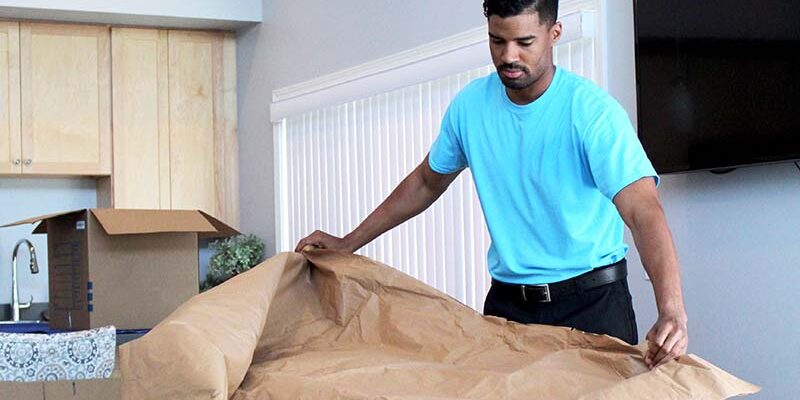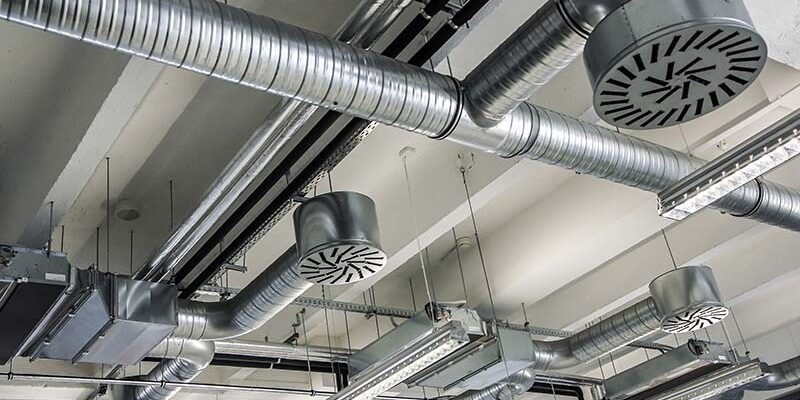Starting a Rug Cleaning Business
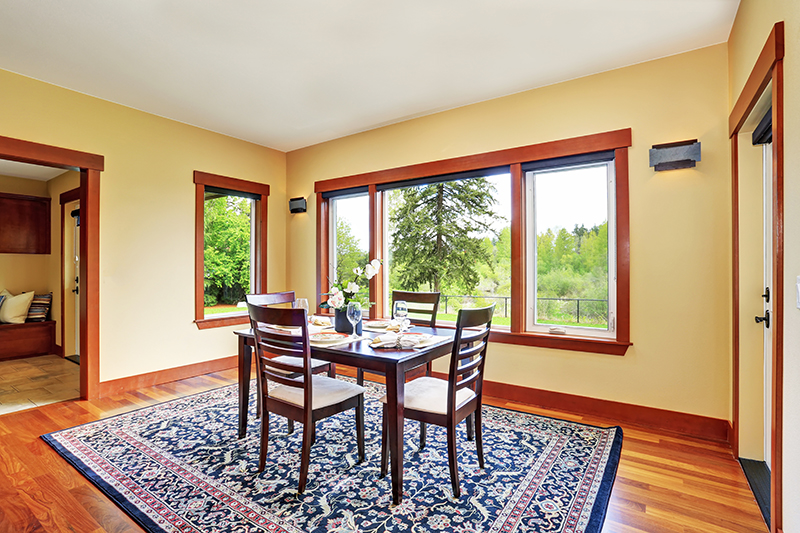
By Amy Hughes
For carpet cleaners looking to diversify and expand their business, adding rug washing services may seem like a logical next step. While rug washing can be a solid venture, experts in the field are quick to caution that it should function as a separate business unto itself, not merely an extension of a carpet cleaning operation. Proper rug care involves a new set of skills, a new set of equipment, possibly a new location for your business, and likely a different clientele than the one your carpet cleaning company serves.
We spoke with rug cleaning experts to find out what you should know before branching out into this industry sector.
Know before you start
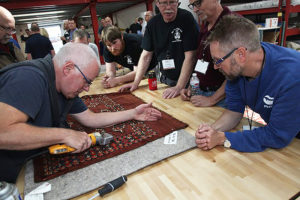
Rug repair being taught at an educational event. Image courtesy of Centrum Force.
As a carpet cleaner, it may be tempting to think that you already know most of what you need to start washing rugs, but Randy Hyde, a 30-year veteran of the industry and owner of Renaissance Oriental Rug Cleaning, says, “Don’t treat your rug cleaning business like it’s part of your carpet cleaning business because it’s different.”
Tom Monahan, co-founder and owner of rug washing equipment manufacturer Centrum Force, knows the importance of looking at the two skills as completely separate. He started out in the carpet cleaning industry in 1977 and didn’t beginning rug cleaning until 2005. Monahan agrees that it takes years of education and experience to develop the skills needed to wash rugs well.
For example, a rug cleaner must know about rug identification, construction, dye methods, and more in order to determine which chemicals and cleaning methods are appropriate. Rugs are often highly valuable textiles and without proper training, inexperienced rug washers can make costly mistakes that hit both your bottom line and your reputation.
A successful rug business begins with a commitment to education and building a strong foundation of knowledge specifically about specialized rug services and equipment. Robert Mann, owner of Robert Mann Rugs in Denver, started as an apprentice in the industry in 1978, learning to restore and reweave damaged rugs. He researched cleaning at the library and began washing in his bathtub. For those new to the industry, Mann suggests spending at least two to three hours every day reading or taking classes.
Monahan says rug washing is not a business to jump into lightly and that there is much for potential owners to consider and become knowledgeable of, including the skills, space, and marketing needed to be successful. You can also diversify beyond rug washing into retail, restoration, and repair, as both Mann and Hyde have, but these areas require additional training and education.
Find your clients
One of the ways a rug washing business differs from a carpet cleaning business is in clientele, so it is important to ensure the demographic in your area would support a rug cleaning operation. Specialized rug services are typically marketed to wealthier clients who have made an investment in a quality rug and are equally willing to invest in the proper care of that rug. Depending on your service area, this pool of clients might not significantly overlap with your current carpet cleaning clients.
Mann advises that before ever starting the business, cleaners should do research on the potential pool of customers by looking at zip codes and home prices. In his city of Denver, he found that most rug washing customers own houses that cost more than $500,000 (this number will of course vary based on the real estate market and cost of living in different cities), so he looked at neighborhoods with a high concentration of houses in this price range to determine his potential pool of clients. Mann stresses that this research is an important step because some locations simply may not have the client base to support a rug washing operation.
If you already operate a carpet cleaning service, connect first with your residential or commercial clients who may have rugs to wash. Hyde adds that it’s also a good idea to engage with rug retailers and restoration companies in your area, as they may be willing to refer customers or subcontract work to you. Monahan suggests that towns with universities, medical centers, and professional businesses are also good candidates for a successful operation because these businesses tend to support a demographic that is likely to take advantage of rug cleaning.
Cost
A top question when exploring any new business venture, of course, is the cost to get started. How much initial capital will you need to start a rug washing business? Can you do it on the cheap?
“The short answer is, ‘sure,’ absolutely you can do it on the cheap,” Hyde says. After all, he started his own business with little more than a bucket and a scrub brush, but it comes at the cost of time and effort. “The cheaper you get, as a general rule of thumb, the more time and labor it’s going to take, so you actually are inherently less profitable.”
It’s possible to start small with less expensive equipment, but ultimately you will be limited by that equipment and may struggle to scale your business and become more profitable until you are able to invest in more efficient equipment. It’s possible to start a rug washing business for $10,000 to $20,000 for something very small and limited, but if you want room to grow and scale, those numbers go up very quickly.

Rug wash floor during an educational event hosted by Robert Mann. Image courtesy of Centrum Force.
Mann says you can expect to spend $100,000 to $300,000 to set up a mid-sized plant that is prepared to wash 3,000 to 4,000 square feet a week because you need more real estate, more water, more power, and big-ticket equipment.
It’s important to know where you’re headed and what you want out of the business before you start so that you can invest accordingly, Monahan explains. Those entering the rug washing arena need to decide if this is just a side hustle or a business that will expand. Think about what you will need a year down the road and even five years down the line and let the business plan drive your purchasing so that you avoid spending a lot of money on equipment that is unlikely to serve your long-term goals.
Location
Since one of the most expensive elements of a rug washing business is the real estate it takes to operate, many potential owners wonder if it’s possible to start the business at home, using real estate you already own. It is possible; both Mann and Monahan started their businesses at home, but it’s challenging.
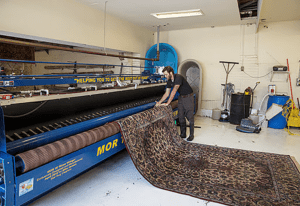
A Star Rug Cleaners technician loading a rinse wringer. Image courtesy of Centrum Force.
Monahan first operated out of a 1,200-square-foot pole barn, but this set-up limited the size and volume of rugs he could service. Hyde, who today operates a larger-end wash plant at 7,000 square feet, points out again that saving money on the location comes at the cost of time and labor, ultimately limiting profitability. He explains that rug washing and drying requires a good deal of space, and even if you can make it work at home in a garage or other space, you will likely spend a lot of time maneuvering the equipment around.
Having a dedicated space with a functional layout becomes important if you want to do a significant volume of business. Mann explains if you are washing 800-900 square feet a week, you can do it with a smaller, cheaper operation and can make good revenue if you work in a market where the rates are high enough. However, if you want to move up to washing 3,000 to 4,000 square feet a week, it’s nearly impossible to do that volume with a smaller operation. He says, “Making that scale jump is very tough because it takes either credit or capital, and a lot of people haven’t got that.”
As for what type of location is needed, Mann explains that a visible location is expensive and not necessary for this type of business. He suggests choosing an industrial location with high ceilings and plenty of space and power to create an efficient operation with the right equipment.
Business model
Another aspect of planning your rug washing business is to determine your precise business model. What kinds of jobs will you take? Who in your company will do the work? Which tasks will you delegate, and which will you do yourself?
The experts say it depends on your own goals and preferences, but they agree that it is beneficial for the owner to start out on the wash floor, performing all the tasks. As the owner, you should know everything about the rug washing process, so don’t start delegating until you build your own expertise.
“I have seen wash operations where some guy on the wash floor knew a whole lot more about the process than the guy who owned the company, and that always seemed dysfunctional to me,” Mann says. The owners we spoke to started out doing all the grunt work out of necessity, but as their businesses grew, they moved into more of a management role.
As for which types of jobs to take and which to subcontract out, the experts say that depends too. It can be smart to contract out some jobs in the beginning because it takes time to develop all the skills needed to run a successful, full-service rug washing business. While you are acquiring the necessary equipment and experience, consider contracting out the jobs you don’t yet know how to do while focusing your business on the skills you’ve mastered. The last thing your business needs is a dissatisfied customer because you took on a job you weren’t prepared for.
Additionally, Hyde points out there may be a strategic reason to contract out certain kinds of work depending on your business model. If a specific type of job slows down the rhythm of your wash plant or requires specialized skills or equipment that won’t pay off for you in the long run, you may simply choose to always contract out those isolated jobs in order to streamline your operation.
Note: Hyde says one common mistake new rug washers make is not being well-organized. He has seen operations where a new owner starts taking in rugs for cleaning without a system in place for ensuring the right rug always makes it back to the right customer. As business volume increases, this can become a huge problem. Hyde recommends a system of tagging rugs when they come in and tracking them as they move through the wash plant and return to the customer. He adds that organization isn’t just about the rugs; new owners need systems to organize their accounting, marketing, and all aspects of the business.
Final tips
Hyde, Mann, and Monahan have more than 85 years of combined experience in the rug cleaning industry, so with all that they now know, we asked them what they would have done differently early in their careers.
Hyde and Mann both said they would invest more in their businesses sooner, such as buying the equipment or real estate needed to scale their business. “I would have taken bigger risks sooner, spent more money sooner, bought more real estate,” said Mann. “Rug washing doesn’t necessarily provide such a fantastic source of revenue, whereas over the long run, investing in equipment, real estate, and people will pay you back.”
Monahan agrees that strategically placing your rug plant can mean that the real estate investment itself becomes your retirement plan more than selling the rug washing business.
Amy Hughes is a freelance writer who has worked with Cleanfax for more than two years and has worked as a writer and editor for more than eight. Reach out to her at [email protected].


